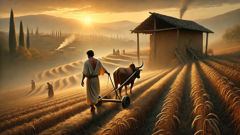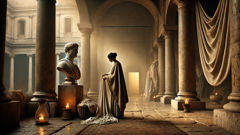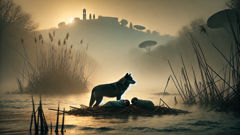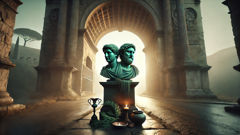Introduction
When people in the valley of Nemea first began to speak of a beast with fur like burnished gold and a hide that laughed at bronze and steel, they offered prayers and sacrifices with trembling hands. Word spreads easily in small places, where shepherds’ songs carry along the ribs of the hills and women gossip at the fountain; rumor, rumor becomes warning, becomes fear. The Nemean Lion did not arrive as a whisper but like a shadow that widened each dusk. It walked the ridgelines and drank the river at dawn, leaving hoofed animals shredded beyond recognition and shepherds’ dogs flattened like rugs. Children pointed toward the caves and refused to fetch wood. Sacrifices left at temples were found ripped from their altars, and even the marble threshold of a shrine bore the deep gouges of claws. The priesthood argued over omens: was this a test from a distant god or the work of Artemis, angered and wild? Some elders insisted it was the earth itself, a mouth opened by older, hotter fears. Whatever its origin, the lion became a presence in the stories people told in their courtyards—less a creature than a weather, a particular type of dread that would not be named without trembling.
It is easy to imagine a monster looking unlike any beast we know; it is harder to imagine one who made men’s weapons useless. Bronze and iron would bend and splinter on its flank. Arrows glanced from brass collars as if from water. Stories said blades sank into the fur and slid off the muscle like fingers glancing down a robe, leaving the steel dull and useless, and those who pressed metal to flesh found swords snapped like reeds. One shepherd swore he saw the lion step from smoke and rock, its coat a living armor creased with flame. Another claimed it drank the blood of a bull without so much as staining its mane. These accounts braided together until Heracles, newly returned from the reaches of human law and divine decree, heard of this grief in Nemea. A prince or peasant, he did not care; what mattered to Heracles was to stand where fear had fixed its teeth in a place and pull it free. The king of the region promised reward, but Heracles wanted something older: a proof of strength that would bind his name to his hands. Thus the first labor began not only in muscle but in conversation and omen, in blows struck in the dark between gods’ will and mortal courage.
I. The Beast and the Valley
The people of Nemea had long been good at marking seasons and naming the stars, at counting lambs and planting in unison with the rain. Their gods were close—so close they named them as neighbors—and offerings were routine as hearth smoke. It was this ordinary pattern of life that the lion began to rend. The first reports were ordinary enough in their particulars: a flock found slaughtered with no blood spilled upon the grass, a herder running to town with his cloak torn to ribbons. But what turned those stories into myth was not merely the scale of the creature’s appetite; it was the way it thwarted human artifice. Spears that had felled boar and shields that had repelled stray arrows were as idle against the beast as nets in the wind. People tried to corner it and found only deep prints and a silence that suggested the creature had been there and had not been there all at once. Night carried its roars across the hills like a bell; day brought the sight of trampled fields and the smell of scorch where someone swore they saw sparks leap off the lion’s mane.

Priests staged rites and scratched auguries into clay. Divination birds refused to leave the eaves; the oracle at a nearby temple muttered of an imbalance. Some said the monster had been born of Hera’s ire, others that it was a punishment from a goddess of the hunt. Children began to avoid one path between two hills because a shadow would fall across it like a hand, and even the brave traders adjusted their routes. It is easy to ascribe legend to fear; harder to say what was true. Men noted that where the lion trod, the grass seemed to glitter in sun and moonlight, and that wolves and jackals gave it a wide berth as if some incumbent law of the wild bound them to different territories. When a father took his son to the cave under the great precipice—though none lingered there long—they found the smell of honey and iron. Old women said the beast tasted of laurel and hot metal. These contradictions made the animal uncanny. It was both part of the land and not, gilded and yet predatory, like a lightning strike that left burnished metal where wood had been.
The stories gathered force. Men took to laying snares and setting fires, to sitting in watch-towers for three nights at a stretch, but clustered torches were no match for something that could move like a shadow and could shrug off bronze. Some hunters who followed tracks into the limestone looked into black caves and found masonry arranged like an altar. A temple once dedicated to a local god now bore the marks of the fight, and prayers left upon the steps were scattered in a way that suggested the animal had sought not prey but symbols. To the villagers the lion seemed to mock the very idea of human order—how could a people whose life circled planting and harvest respond when their seasons themselves were denied? Fear metastasized into ritual. Fathers taught their daughters to tie knots the way their mothers had taught them, and elders clasped amulets until their knuckles whitened. People began to measure time by the beast’s visits, and the name 'Nemean' became a bruise upon the valley, a way to speak about days when the sun could not make the fields safe.
News of the lion spread outward as travelers left Nemea’s narrow paths for broader roads. Merchants traveling to Argos and beyond told the tale at inns, and those tales were embroidered by time and distance. A hunter at Delphi added a shrug of divine jealousy to the narrative; a captain at Corinth claimed the lion had once boarded a merchant’s ship and wreaked havoc on its deck. It was at this height of rumor and fear that Heracles, recently embroiled in a life of complicated bonds between mortals and gods and bound by a set of labors that would be his atonement and his proving, came to know of Nemea’s plight. He was a figure woven of contradictions—a man whose strength was legendary and whose heart could be at once generous and stormy. For him, the lion posed a rare clarity: a single, immediate injustice needing muscle and cunning. He believed that to remove terror from a place was not merely to kill a beast but to unspool the knot of fear that tied people’s lives to an ominous rhythm. That conviction sent him into the valley with two aims: to end the lion’s terror, and to test whether human force, applied with mind and relentlessness, could do what temples and omens had not.
Yet there was more than muscle at stake in confronting a creature whose hide rebuked weapons. Heracles had learned from other labors that gods could twist mortal deeds into snares; beasts could be symbols for greater moral knots. To approach the lion was to approach a boundary between animal and omen, between the way the world had always been and the way men hoped it might be again. Villagers watched from behind shuttered windows as Heracles paced the ridgeline at dusk, club slung over his shoulder, a mantle thrown about him. He was not merely a man; he embodied an answer. When he silently descended into the valley, narrowing his focus to the cave and the prints at its mouth, the people felt something like hope—an old, thin thread made flesh. They did not yet know whether this thread would hold, but for the first time since the harvests were ruined, they dared to lay down a meal without fearing the footsteps that had once raked their roofs.
II. The Hunt and the Cave
Heracles did not begin the hunt like a man hunting deer for winter. He moved with a studied patience that belied his great frame. The first task was to observe: to walk the perimeter of the fields, to note the depth of the tracks at a watering hole, to follow the animal’s pathways past places where flocks grazed and to the limestone that teeth had worn smooth and dark. He sent no army, no band of hunters that might alarm the beast; he preferred a narrower approach, a quiet study that would reveal both habit and hazard. Villagers saw him come and go, sometimes day after day, and they grew to measure his vigil against the beast’s absences. He learned, in those patient hours, to read the signs—how the grass bent where a shoulder had pushed past, where a tuft of golden fur snagged on a thorn bush, and how the rocks near the cave mouth bore curious scrape marks. In the light between sunset and moonrise, Heracles would sit on a stump and listen. A distant roar would twist in the air like a drum; an animal’s breath would fog against his beard. He began to map the lion’s rhythm: it would hunt at edges where olive groves met open field and it would return to the cave at an hour when lanterns were guttering in hearths.

On the night he chose to enter the cave, Heracles moved like a tide. He did not bring his bow or spear, understanding that metal might be useless and publicly demonstrable failure would only deepen the valley’s dread. Instead he brought his bludgeon, a heavy club wrought from an old oak that had survived lightning. He brought also a calm honed by many nights awake in bitter cold, an unglamorous readiness. The cave’s entrance yawned like a mouth: a black amphitheater that inhaled the light. Inside the air smelled of old earth, of laurel leaves and something animal and hot, and his torch cast the cave walls gold for a moment before the darkness took them back. The lion’s lair was a nest of bones and trampled reed; there were remnants of offerings—broken pins of bronze, beads of glass, and an overturned bowl with a smear of wine. The cave felt watchful, the stone set like teeth. Heracles hesitated only long enough to breathe and set his shoulders; then he stepped into the dark.
The first contact was not cinematic. There was no grand roar that announced the battle; rather the lion moved like a shadow in the torchlight, its shoulders bunched, its breath a furnace. Heracles struck quickly, but not recklessly; he learned that striking metal against the hide dulled the weapon’s edge. A spear grazed the lion and snapped with a single, ashamed sound. The creature’s eyes caught the torchlight and blazed like coals, and for a moment it looked less like a beast and more like a column of living twilight. Heracles felt the blow of its paw like a wind that rearranged his ribs; he tasted the tang of iron in his mouth. The fight in the cave is remembered in many ways—some say Heracles strangled the beast with his bare hands, others that he pinned it and smote it with a club until the life left its body. The truth is less simple than the legends; it was a long, brutal wrestle where muscle met muscle, where the hero’s steady intelligence had to find purchase on a hide that would not admit the edge of a blade. He trapped the lion against a narrow shelf of rock so that it could not swing its full weight and used his arms, braced beneath its throat, to cut off breath, to seize the beast’s advantage away.
There are moments in such combats when time does strange things. Sounds tauten, the smell of fur becomes a color, and one’s body keeps a ledger of every bruise. Heracles felt his arms burning, his breath a hot, useless animal in his chest, and his mind moved between the single-minded focus of the fight and memories of his own kin—his mother’s hands, a father’s disappointed look, the faces of those he loved. Such recollections could have been a distraction, but in the cave they became instruments; the memory of a child’s small hand urged him to hold on, to find leverage where the lion found none. When finally the beast’s head lolled and its roar slackened, a silence poured into the cave that felt like winter. He did not leap up triumphant; he was too aware of the cost. The animal’s breath had stopped because of his hands. Its golden fur lay like dusk on the floor, and the cave took back its roar as if nothing unusual had occurred.
Exiting the cave with the lion’s body slung over his shoulders, Heracles walked through a world that seemed to blink in sunny disbelief. The villagers who had kept watch on distant ridges gathered at the sight—some fell to their knees, others cried out in joy that was wrung through with horror. The priests came forward, trembling and relieved, to press garlands of laurel around the neck of the dead beast as if to reclaim what had been desecrated by terror. Heracles understood that the fight was not finished; in killing the creature he had to do what mortals do best when confronting the animate mysteries—he had to turn the raw thing into an object of meaning. That meaning took shape in the skin. The hide would not yield to knife and needle in the ordinary manner; Heracles, using the lion’s own claws and a sharp stone, flayed the pelt with the same mixture of patience and muscle he had used in the battle. He fashioned the skin into a mantle and pressed its jaws over his own head until the great teeth framed his face like a crown. It was then, draped in the lion’s own invulnerability, that Heracles looked less like a man and more like a sign: human courage wearing the armor of the earth’s own impossible things, a walking paradox meant to teach the world that where fear has a face it can be looked at, and where that face can be suppressed, order might be reclaimed.
III. Skin of Gold and Song of Men
After the lion’s silence, the valley of Nemea felt its breath return in slow, tremulous waves. Everyday rhythms picked up like a clock struck after a long pause: women drew water again from the spring without looking over their shoulders, shepherds let dogs run ahead of them across fields, merchants reopened stalls that had been shuttered. But life rearranges itself around meaning, and a dead thing left alone can be a source of chaos if not understood. The lion’s skin—impossible in its resistance—became a symbol the people could debate and priests could interpret. Some wanted the pelt consecrated and stored in the temple as an offering; others wanted Heracles to leave it to the shrine as proof that mortal hands, aided perhaps by the gods, had restored the valley. Heracles himself saw the pelt differently. Wrapped in the lion’s hide, he felt the weight of an answer upon his shoulders. The skin was not merely clothing; it was a lesson in paradox: he had used intelligence and endurance to conquer a force that appeared to defy those very measures, and now he wore the cause of people’s fear as both protection and testimony.

The process of turning the hide into armor was both practical and ritual. Leatherworkers and wise women helped Heracles treat the pelt, scraping and preserving it with salt, smoke, and oils until it would not rot. They stitched it with sinew and braided bands of leather into a mantle that curved around his shoulders, the head of the lion forming a hood. The teeth and the jaws were kept so that when Heracles drew the hood over his head, the world saw that he had not only slain the beast but had made its triumph a thing to be borne by man. That night, the villagers sang a new song. It spoke of a man who had stood between their hearths and the dark, who had gone into the cave alone and brought back an answer. They called Heracles a hero because he had restored a practicable, everyday safety; they made him myth because the manner of that restoration spoke directly to the ways men confront meaning when ordinary tools fail.
The story of the lion continued to ripple beyond the valley. Bards sang the tale at courts and marketplaces, each adding their own accent: some emphasized the brute strength, others the cunning; the priests in Argos claimed a special proprietorship, and in Olympia scribes wrote down lines about the prodigy of a hide that repelled the spear. In time, the lion’s skin became a motif in pottery and in the carved relief of temples: a man with a lion’s head draped over his shoulders, a combination of tenderness and terror, a man who sheltered himself with proof of victory. For Heracles, the mantle was both shield and burden. It marked him as different—someone who had communed with danger and emerged bearing it—and that difference shaped how others asked for his aid. Wherever he went next, people saw the lion’s jaw and understood the scale of his courage. The mantle became an extension of his body, and in many tales the leather itself takes on near-magical qualities: it is impervious and protective, a talisman that aligns human flesh with something of the wild’s stubbornness.
Beyond the personal, the Nemean Lion’s tale became a cultural instrument. It taught the community how to narrate recovery from extraordinary fear. Where the lion had once made people change their routes and hide in the night, they learned to tell a story that restored the sense of time and place. Rituals shifted: harvest songs reacquired confidence, and the local shrine that had once been desecrated regained its offerings with new rites that honored both the gods and the courage of their champion. The moral, if there is one to be chunked from a myth that resists didactic simplicity, is that facing an apparently invulnerable force requires both force and inventiveness; it requires that people be willing to enter dark places and exert brutal persistence while imagining a different order on the other side. The lion’s skin, gorgeous and terrible, taught them how to carry the grotesque fact of danger into the world and press it into something they could touch and understand.
The long effect of this labor is more than the immediate absence of a predator. Heracles’ act resonated in a way that held lessons about fame, about the mingling of human deeds with divine attention, and about the ethics of power. He had not destroyed the lion to feed a vanity; he had undone a public calamity and then worn its sign to remind both himself and others of the cost of such deeds. In later retellings the mantle grows more than a trophy; it becomes a visible record, a liturgy stitched in sinew and courage, that tells any who see it the story of a man who accepted the dense texture of fear and, by steady action, rewove a community. The people of Nemea, when they looked back, counted this labor as the beginning not merely of Heracles’ exploits but of their own reassertion of life. Where the lion had once reigned like a dark weather, the valley learned to measure time by new songs and new festivals, and even the fields seemed to breathe easier. In that way, a single battle in a cave between a man and a golden hide became a hinge upon which more ordinary human things—trade, marriage, planting—could swing back into place. The story continued to be told because it was not only a story of strength but of hands that made meaning from danger.
Conclusion
Legends tend to gather features like salt: they preserve and they intensify. The Nemean Lion's tale, when seen from the long view, remains striking because it marries a literal struggle to an idea about how people live with danger. Heracles' solution combined endurance, intelligence, and a willingness to touch the thing that scared everyone; he did not merely refuse fear, nor did he rely solely on divine favor. He walked into a cave, sustained a brutal test of body and will, and emerged wearing a trophy that was also a teaching. For the valley of Nemea the effect was practical—fields were safe, altars cleansed—but it was also symbolic: a community learned to tell itself that terror could be faced, that the kinds of protection humans have—whether leather, law, or myth—are ways of binding the world back together after something monstrous unthreads it. In the centuries that followed, when potters painted a man with a lion's head upon an amphora, or when poets named Heracles in hexameter, they were not only singing of a single encounter; they were rehearsing the hard lesson that courage often arrives as a slow, awkward art, and that the bravest acts are measured not only by the strength they show but by the lives they return to daily rhythms. The Nemean Lion disappears from the valley, but its memory is sewn into the fabric of human speech; people learned how to salvage meaning from fear, and they taught their children to sing of a man who, wearing the hide of a beast, reminded them that the world can be mended by hands willing to get bloody for the sake of ordinary life.













